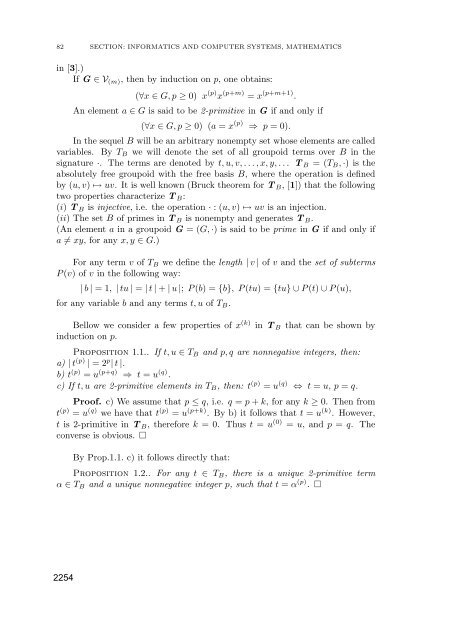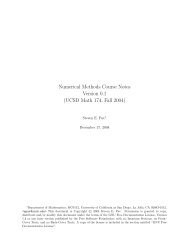FREE OBJECTS IN THE VARIETY OF GROUPOIDS DEFINED BY ...
FREE OBJECTS IN THE VARIETY OF GROUPOIDS DEFINED BY ...
FREE OBJECTS IN THE VARIETY OF GROUPOIDS DEFINED BY ...
You also want an ePaper? Increase the reach of your titles
YUMPU automatically turns print PDFs into web optimized ePapers that Google loves.
82 SECTION: <strong>IN</strong>FORMATICS AND COMPUTER SYSTEMS, MA<strong>THE</strong>MATICS<br />
in [3].)<br />
If G ∈V (m) , then by induction on p, one obtains:<br />
(∀x ∈ G, p ≥ 0) x (p) x (p+m) = x (p+m+1) .<br />
An element a ∈ G is said to be 2-primitive in G if and only if<br />
(∀x ∈ G, p ≥ 0) (a = x (p) ⇒ p =0).<br />
In the sequel B will be an arbitrary nonempty set whose elements are called<br />
variables. By T B we will denote the set of all groupoid terms over B in the<br />
signature ·. The terms are denoted by t,u,v,...,x,y,... T B =(T B , ·) isthe<br />
absolutely free groupoid with the free basis B, where the operation is defined<br />
by (u, v) ↦→ uv. It is well known (Bruck theorem for T B ,[1]) that the following<br />
two properties characterize T B :<br />
(i) T B is injective, i.e. the operation · :(u, v) ↦→ uv is an injection.<br />
(ii) The set B of primes in T B is nonempty and generates T B .<br />
(An element a in a groupoid G =(G, ·) is said to be prime in G if and only if<br />
a ≠ xy, for any x, y ∈ G.)<br />
For any term v of T B we define the length | v | of v and the set of subterms<br />
P (v) ofv in the following way:<br />
| b | =1, | tu | = | t | + | u |; P (b) ={b}, P(tu) ={tu}∪P (t) ∪ P (u),<br />
for any variable b and any terms t, u of T B .<br />
Bellow we consider a few properties of x (k) in T B that can be shown by<br />
induction on p.<br />
Proposition 1.1.. If t, u ∈ T B and p, q are nonnegative integers, then:<br />
a) | t (p) | =2 p | t |.<br />
b) t (p) = u (p+q) ⇒ t = u (q) .<br />
c) If t, u are 2-primitive elements in T B , then: t (p) = u (q) ⇔ t = u, p = q.<br />
Proof. c) We assume that p ≤ q, i.e. q = p + k, for any k ≥ 0. Then from<br />
t (p) = u (q) we have that t (p) = u (p+k) . By b) it follows that t = u (k) . However,<br />
t is 2-primitive in T B , therefore k =0. Thust = u (0) = u, and p = q. The<br />
converse is obvious. □<br />
By Prop.1.1. c) it follows directly that:<br />
Proposition 1.2.. For any t ∈ T B , there is a unique 2-primitive term<br />
α ∈ T B and a unique nonnegative integer p, such that t = α (p) . □<br />
2254














